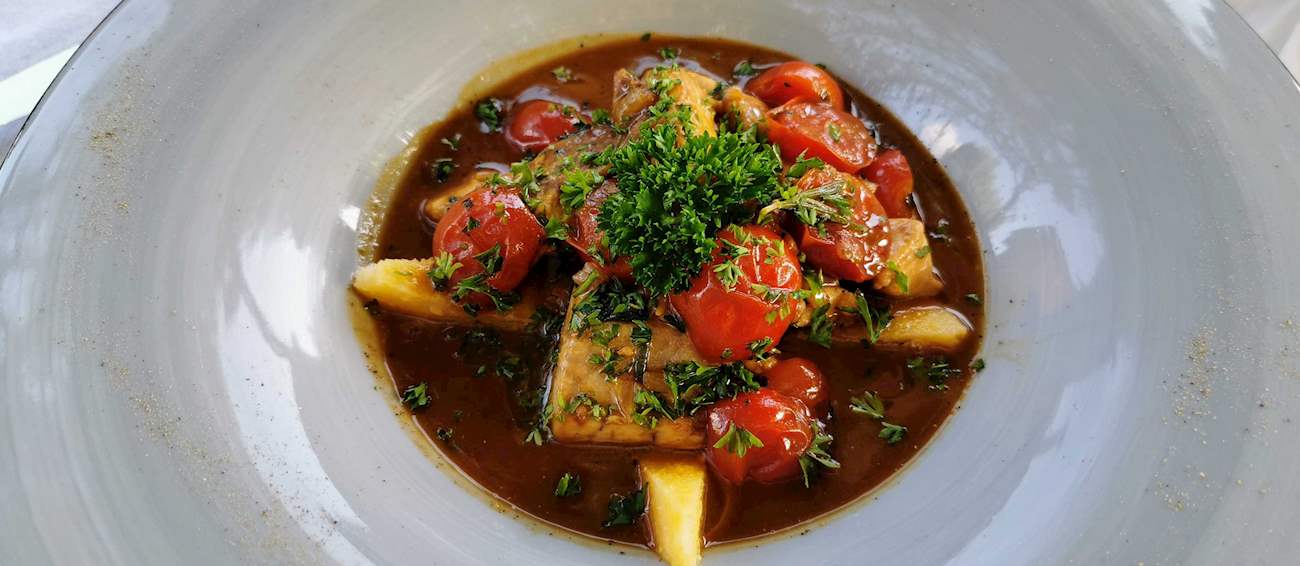MAIN INGREDIENTS
Šaran u rašljama is a traditional dish that is a specialty of the Croatian region of Baranja. It consists of a large carp that is placed in a divining rod and slowly cooked over a wood fire, giving it a unique smokiness and aroma.
About ten minutes before the carp is fully cooked, it is sprinkled with salt and ground red paprika for extra flavor. It is recommended to serve the carp with spring onions, a potato salad, and a glass of white wine on the side.
MAIN INGREDIENTS
Brudet is one of the true classics of traditional Croatian cuisine. Prepared with a variety of seafood, this rustic stew is consumed along the entire Croatian coast. It is nearly impossible to find a unique brudet recipe, since every region, town, and household have their favorite version of the dish.
General guidelines suggest that at least three different types of fish should be used – always cut into larger chunks and left on the bone. Scorpionfish, monkfish, sea bass, or any other white-fleshed fish is suitable for brudet. The addition of shellfish such as mussels and scampi is a desirable complement since they considerably contribute to the flavor.
MOST ICONIC Brudet
View moreMAIN INGREDIENTS
Grilled sardines are a simple, traditional seafood dish especially common in coastal Mediterranean areas and during summer months, when fresh sardines are plentiful. The dish is straightforward and emphasizes the natural flavors of the sardines: they are typically marinated in a mixture of olive oil, lemon juice, black pepper, and salt (although a variety of spices and herbs can also be added, depending on the region) before being grilled over a charcoal fire.
The dish is usually served as an appetizer or a part of a meze, along with bread, boiled potatoes, sautéed vegetables, or salads, and is best paired with lighter, sweeter local white wines.
MAIN INGREDIENTS
Perkelt od soma is a traditional delicacy from the Croatian region of Slavonija and Baranja, which is heavily influenced by Hungarian cuisine. This variation of the Hungarian pörkölt stew is made with sliced catfish and a combination of onions, garlic, ground red paprika (both mild and hot varieties), and bacon.
After the stew has been cooked, it is traditionally served accompanied by homemade noodles mixed with cheese and bacon bits. Along with fiš paprikaš and čobanac, this flavorful stew is a staple at numerous restaurants in Baranya County.
MOST ICONIC Perkelt od soma
View moreMAIN INGREDIENTS
This simple fish stew with potatoes is said to be the oldest way of preparing fish in Dalmatia and was probably brought to the area by Greek settlers more than 2000 years ago, although potatoes are a local modification because they were introduced considerably later.
Traditionally, the dish is made by layering together thinly sliced potatoes and onions which are then drizzled with olive oil, topped with smaller white saltwater fish, and cooked in just enough water and white wine to cover the fish—usually with the addition of parsley and garlic, whereas modern recipes often include ingredients such as capers and salted anchovies.
MOST ICONIC Gregada
View moreMAIN INGREDIENTS
Fiš paprikaš (or hal paprikas in Hungary, with the addition of sour cream) is a traditional stew cooked in a big cauldron over an open fire. This spicy fish stew is traditionally made with a variety of freshwater fish such as catfish, starlet, pike, and carp.
The stew is heavily flavored with large amounts of the region's staple – ground red paprika, which can range from mild to very hot. Fiš paprikaš is often served with homemade noodles, and it is so popular in the region that there are numerous fiš cooking competitions organized throughout the year.
MOST ICONIC Fiš paprikaš
View moreMAIN INGREDIENTS
Pijani šaran (lit. drunken carp) is an unusually named, traditional dish of the Croatian region of Slavonia and Baranya. The gutted, cleaned carp is traditionally salted and stuffed with numerous garlic cloves, then baked in an oven with flavorings such as lemon juice, wine, oil, and rosemary.
The dish is typically garnished with lemon slices and parsley, while baked potatoes are often used as an accompaniment to this delicious and healthy meal. Although drunken carp is not a common restaurant staple outside of the region, it is quite easy to prepare the dish at home.
MAIN INGREDIENTS
Out of the numerous varieties of Croatian brudet, the one that hails from the Neretva region is considered unique since it usually employs eels and frogs, two traditional ingredients used in the area. It is said that every village in the region has a different recipe, but the basic version employs thoroughly cleaned pieces of eels and frogs that are sautéed alongside olive oil, onions, and garlic.
They are later braised in a combination of seafood stock, fresh tomatoes, chili peppers, and a touch of vinegar. Though tradition suggests the use of eels and frogs, the dish is commonly enriched with other fish varieties. Regardless of the differences, every version of brudet is always prepared in a traditional, heavy-bottomed pan and should never be stirred.
Srdele na gradele is a traditional dish originating from Dalmatia. It's made by grilling fresh sardines over an open flame on a metal grate called gradele. The sardines should be as fresh as possible. They're simply drizzled with olive oil and seasoned with salt.
After a few minutes of grilling on each side, the sardines are drizzled with a mixture of olive oil, chopped parsley, and garlic. Lemon juice, rosemary, and white pepper are all welcome additions that provide extra flavor to the sardines. All along the Dalmatian coast, this dish is usually accompanied by boiled potatoes, chard, or grilled vegetables.
MAIN INGREDIENTS
Bakalar po domaću is a traditional fish dish originating from Kvarner and Istria. The dish is usually made with a combination of dried cod, potatoes, onions, garlic, parsley, tomatoes, tomato paste, olive oil, salt, and black pepper. The cod is soaked and cooked in boiling water.
The potatoes are cut into slices, while the onions and tomatoes are chopped and sautéed in olive oil with parsley and garlic. The potatoes, cod, and sautéed vegetables are placed in the pot in alternating layers (the top layer is always potato), and then covered with cold water and simmered over low heat for five to six hours.
TasteAtlas food rankings are based on the ratings of the TasteAtlas audience, with a series of mechanisms that recognize real users and that ignore bot, nationalist or local patriotic ratings, and give additional value to the ratings of users that the system recognizes as knowledgeable. TasteAtlas Rankings should not be seen as the final global conclusion about food. Their purpose is to promote excellent local foods, instill pride in traditional dishes, and arouse curiosity about dishes you haven’t tried.











